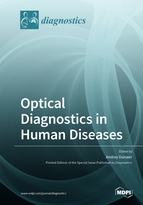Optical Diagnostics in Human Diseases
A special issue of Diagnostics (ISSN 2075-4418). This special issue belongs to the section "Optical Diagnostics".
Deadline for manuscript submissions: closed (31 December 2020) | Viewed by 37560
Special Issue Editor
Special Issue Information
Dear Colleagues,
Light-based technologies present unique opportunities for the diagnosis of various pathological disorders of biological tissues. With the advancement of modern science, they allow for the non-invasive identification of diseases in the early stages. The range of applications of optical technologies in clinical practice is quite wide, since the optical properties of biological tissues are subject to significant changes in the development of the disease.
This Special Issue will highlight advantages and unique aspects of the use of optical diagnostic methods in identifying and evaluating various diseases and pathological conditions. Articles may focus on the application of technology, disease, or other aspects of the use of spectroscopy and imaging in clinical practice. Articles should reflect novel innovative research and emerging ideas.
Assoc. Prof. Andrey Dunaev
Guest Editor
Manuscript Submission Information
Manuscripts should be submitted online at www.mdpi.com by registering and logging in to this website. Once you are registered, click here to go to the submission form. Manuscripts can be submitted until the deadline. All submissions that pass pre-check are peer-reviewed. Accepted papers will be published continuously in the journal (as soon as accepted) and will be listed together on the special issue website. Research articles, review articles as well as short communications are invited. For planned papers, a title and short abstract (about 100 words) can be sent to the Editorial Office for announcement on this website.
Submitted manuscripts should not have been published previously, nor be under consideration for publication elsewhere (except conference proceedings papers). All manuscripts are thoroughly refereed through a single-blind peer-review process. A guide for authors and other relevant information for submission of manuscripts is available on the Instructions for Authors page. Diagnostics is an international peer-reviewed open access semimonthly journal published by MDPI.
Please visit the Instructions for Authors page before submitting a manuscript. The Article Processing Charge (APC) for publication in this open access journal is 2600 CHF (Swiss Francs). Submitted papers should be well formatted and use good English. Authors may use MDPI's English editing service prior to publication or during author revisions.
Keywords
- biophotonics
- optics
- spectroscopy
- imaging
- diagnostics







